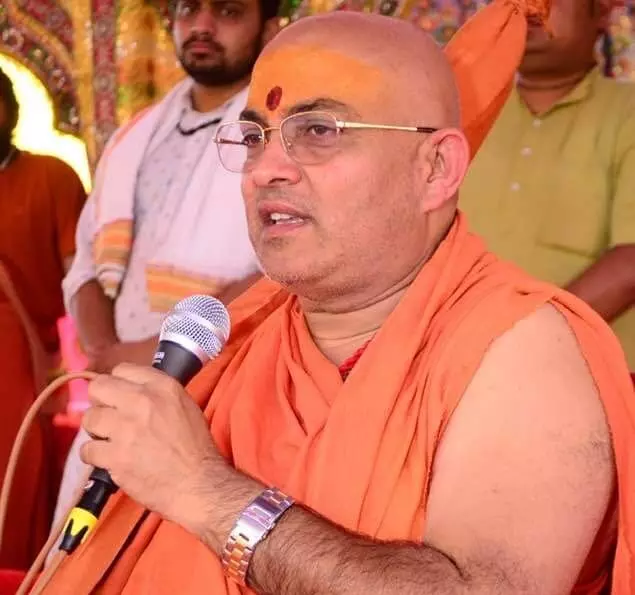
Employment and Economic Significance of Temples in India: A Cultural Perspective
Sam Pitroda's Shortsightedness: Neglecting Temples' Contributions to Employment and GDP

- Swami Jitendranand Sarswati
In a recent statement, Sam Pitroda, the President of Indian Overseas Congress, seemingly made a conscious effort to tarnish the reputation of Sanatan Hindu Dharma and India. Pitroda deliberately expressed a perspective that undermined the importance of temples in addressing India's socio-economic challenges. However, Pitroda's remarks reveal a profound ignorance of Indian culture and the historical role that temples have played. Temples in India have long served as cornerstones of the economic and social fabric, contributing to employment, education, healthcare, and national cohesion.
Historical Context: Temples as Cultural Anchors
India's cultural heritage has long been intertwined with temples and religious practices. The Islamic invasion saw the destruction of numerous temples, as the invaders recognized the deep-rooted connection between temples and Indian culture. Despite this, India is home to an impressive number of temples, including 33,008 unique temples that have withstood the test of time. These temples, such as the Twelve Jyotirlinga, Twelve Ganapati, 52 Shaktipeeths, Nine Durga, and Ten Mahavidya temples, symbolize national unity and the integrity of India.
Current Temple Landscape
Out of the approximately 20 lakhs (2 million) temples in India today, nine lakhs (900,000) belong to the Sanatan Hindu Samaj. Additionally, there are 2.5 lakh (250,000) Sikh Gurdwaras, which include 12 Gurudwaras established by the Gurus for special purposes. The rest of the Gurdwaras are officially recognized as temples. Similarly, more than two lakh (200,000) Jain temples are registered as temples.
Management of Temples
It is important to note that only five lakh (500,000) temples are currently under the control of 127 sects and 13 akhadas of the Sanatan Hindu culture. The remaining temples were acquired by the British India Government through the "Madras Hindu Temple Act" and subsequently governed by the "Hindu Religious Place and Temple Amendment Act, 1951." This government control over temples raises questions regarding the autonomy and administration of these sacred sites.
Employment and GDP Contributions
While Pitroda criticized the focus on temples and deities, he failed to acknowledge the employment and economic contributions they generate. India's religious sector provides employment to a staggering 350 million people, whereas the combined jobs in the central and state governments amount to only 35 million. This clearly demonstrates the significant role that temples play in job creation and sustaining livelihoods.
Furthermore, Pitroda neglected to mention the employment opportunities within the religious sectors of Islam and Christianity. India is home to 250 million Muslims and 40 million Christians, with 3.5 lakh (350,000) mosques, 1 lakh 70 thousand (170,000) Catholic churches, and 1 lakh 10 thousand (110,000) Protestant churches. Considering the sizable Muslim and Christian populations and the presence of numerous religious institutions, it is crucial to evaluate their contributions to employment and GDP.
Tourism and Economic Stimulus
Temples have a remarkable impact on tourism, generating significant economic activity in the regions where they are located. A prime example is the city of Varanasi, which witnessed a surge in the number of pilgrims after the inauguration of Srikashi Vishwanath Dham. The increased footfall translated into a boost for the hospitality sector, with over seven crore (70 million) individuals staying in hotels and dharamshalas. The resulting economic benefits extended beyond tourism, including tax revenue from various sources, agricultural income, and earnings for boatmen, rickshaw pullers, and wheelchair drivers.
Economic ripple effects are undeniable and demonstrate the positive impact of temples on regional development.
Pilgrimage Economy
Haridwar, Badrinath-Kedarnath, Shri Mahakal Lok, Somnath Temple, Ambaji Temple, and other pilgrimage sites have become vital centers for both spirituality and employment generation. These destinations attract millions of devotees annually, leading to the establishment of hotels, dharamshalas, and other supporting industries. The economic sustenance of local populations, particularly in regions like Uttarakhand, heavily relies on the income derived from pilgrimage-related activities.
Individuals such as Sam Pitroda, who dismiss temples as inconsequential in tackling India's socio-economic issues, are actively seeking to defame the reputation of Sanatan Dharma and the nation itself. Temples possess profound cultural importance and have remained an inseparable aspect of India's legacy for countless generations. The undeniable economic influence they wield is exemplified by their ability to generate employment opportunities for millions and serve as catalysts for regional advancement. It is imperative that we acknowledge and admire the temples' contributions to both the Indian economy and society as a whole. Only by embracing and comprehending our abundant cultural heritage can we harness its potential to usher in a prosperous future.
(Author is the National General Secretary of All India Sant Samiti and Ganga Mahasabha)


